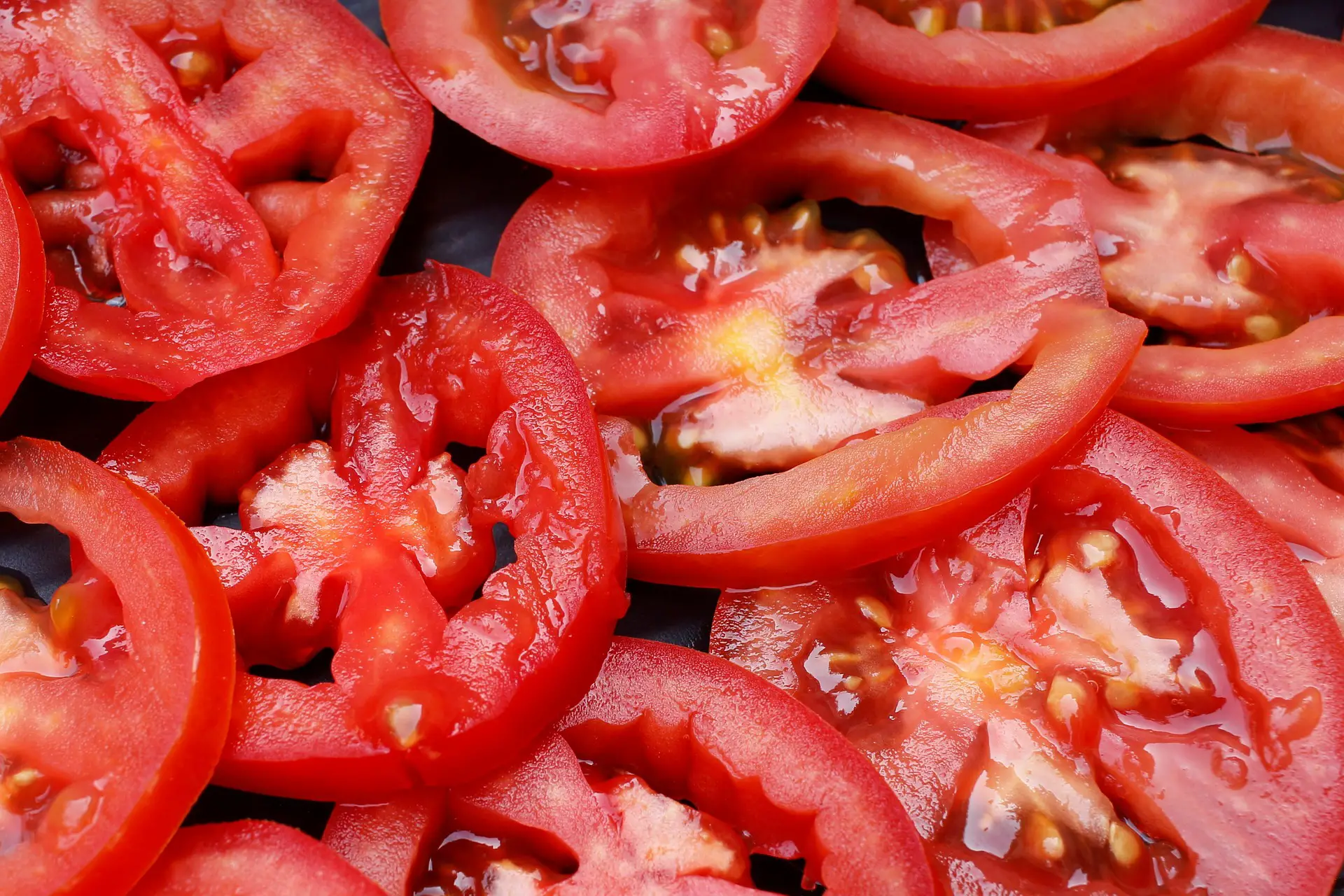If you like to prepare soups and sauces, you can freeze diced tomatoes to keep them fresh and ready to use in the future. By preserving these ingredients, you can enjoy them in your favorite dishes, even without spending a fortune in the store.

Can you Freeze Diced Tomatoes?
Like other fruits, your diced tomatoes can be frozen and kept for later use. You can purée, cut, or freeze whole cherry tomatoes while in storage. Regardless of your method, they will deliver the same tenderness and juiciness when you defrost them and add them to your dish.
When storing diced tomatoes, use high-quality freezer containers as one precaution because tomatoes grow when frozen, and poor-quality containers may crack open under pressure. Instead of using containers, you can store your diced tomatoes in strong, high-quality freezer bags.
How to Freeze Diced Tomatoes?
Perhaps you have an excess of fresh diced tomatoes or a can of diced tomatoes that isn’t quite empty that you’d like to keep. Whatever the case, freezing is among the finest ways to preserve diced tomatoes. The best techniques for freezing chopped tomatoes are shown below.
1. Freezing Fresh Diced Tomatoes
Storing diced tomatoes with the skin on is one of the simplest methods. When freezing fresh tomato dice, this method works best.
Arrange your diced tomatoes on a spotless baking sheet and freeze them there. This allows you to split them out and save them for soups, stews, and other dishes. The tomatoes can be moved from the sheet into freezer bags once frozen.
2. Freeze Sliced Tomatoes in Stew
By briefly boiling your diced tomatoes before freezing, you can also preserve them. Place the unused diced tomatoes in a pot. When they are tender, cook them for more than 20 minutes with a cover on them. The cooked tomatoes’ pan base can be cooled by submerging in ice water.
You may transfer your tomatoes to freezer bags or containers for simple stacking once they have warmed up to room temperature. Then, until you need them again, keep your diced stewed tomatoes in the freezer.
3. Store them in the Freezer
One of the best ways to store diced tomatoes is to freeze them. They can be stored in freezer bags for many months without any problem.
To store diced tomatoes in the freezer, start by washing them. Remove any stems and cores. Washing the tomatoes will also help remove any debris that may have attached itself to the fruit. Alternatively, you can use a food processor to puree the tomatoes. This will allow you to get the most out of your tomatoes.
After cleaning, dry them well. Spread them out in a single layer on a tray that will fit in your freezer. Be sure to leave at least one inch of space at the top.
Next, pour the tomatoes into a storage bag. Use heavy-duty freezer bags to maximize storage. Using a vacuum sealer is also an option. It will remove any air from the bag and help preserve the tomatoes’ freshness.
4. Preserve them for Soups and Sauces
If you want to preserve diced tomatoes for soups and sauces, there are a few ways to do it. Freezing is a great option, but keep in mind that it may affect the texture of the tomatoes. A more thorough method, called blanching, is also possible.
The most basic way to freeze diced tomatoes is to place them in a freezer bag. Seal them tightly. This way, you can preserve the texture of the tomatoes while keeping the flavor.
You can also freeze the whole tomato. These are the tinned variety and give you more control over the flavor of your recipe.
Other methods you can use to preserve the tomato include drying and canning. Drying can be done in a dehydrator or an oven. It’s worth mentioning that dried tomatoes are also good in salads and soups.
Canning is an excellent way to preserve the flavor and nutrients of your ingredients. The process involves removing the skins and seeds from the tomatoes and transferring them to airtight containers.
How to Make Diced Tomatoes?
Still, tomato rain is falling. Many of them! Time to prepare my go-to recipe for diced tomatoes!
We presently have an overabundance of cherry (hello cherry tomato sauce, slow cooker tomato sauce, and spicy tomato sauce! ), beef (hey tomato pie), and Roma (hello Roma tomato sauce, handmade tomato paste, and fresh tomato salsa! Fresh vegetables in the kitchen make me happy, but they also make me feel a little anxious because I know I have to work on them and start canning our tomatoes to survive in the upcoming months.
Generally, we only purchase tomato sauce or other tomato-related products around May and June. Fresh tomatoes are abundant in July, August, and September, while canned or frozen tomatoes are available from October through April.
When you can still eat some fresh tomatoes you grew months ago when the garden wasn’t covered in snow on a chilly wintry day, it’s always a special feeling.
What are the Best Tomato Varieties to Freeze?
Any grape tomatoes or slicing kinds shouldn’t be frozen, in my opinion. Grape tomatoes appear to be challenging to use. I would instead concentrate on cultivars that are suitable for canning. The finest tomato kinds for freezing are Romas, San Marzano, or medium-sized tomato cultivars. Additionally, I prefer juicier tomatoes for this. They have a fantastic flavor and will taste great in sauces, soups, and stews you make during the winter.
How to Use Frozen Tomatoes?
Spaghetti sauce and stewed tomatoes are the only two things I normally make with frozen tomatoes. These two items may resemble one another, but I stick to my tried-and-true tomato sauce recipe and merely increase the cooking time to account for the additional moisture that will leak out of the frozen tomatoes.
You can also use your preferred spaghetti sauce recipe; simmer it for an additional hour to allow the liquid to evaporate. The flavor that the new (but frozen) tomatoes offer is unmatched, in my opinion. Although I am neither Italian nor a spaghetti sauce specialist, the recipe my family has been using for the past 30 years was created by an Italian. Therefore I believe there is some merit to it. (Unfortunately, Sophie Kay’s Italian Cooking, the original cookbook, is no longer available.)
I don’t see why you couldn’t use tomatoes in other cold soups and stews if you dice them into smaller bits. Just be aware that the texture of the tomatoes will not be the same as when using fresh.
Can you Freeze Cherry or Grape Tomatoes?
Yes, but there is no need to peel or blanch grape or cherry tomatoes first because they are so little. They must only be rinsed, dried off, and then frozen on a cookie sheet until solid before being put in a freezer bag.
Should you Peel Tomatoes Before Freezing them?
How you freeze the tomatoes will determine the answer.
- You DO NOT need to peel the tomatoes if you are freezing them raw.
- Given how well the hot water loosens the skins, you might as well peel the tomatoes before blanching them. The skin comes off with just your fingers!
Just keep in mind that tomato peels are loaded with nutrients. You can leave the peels on if you’re going to purée the tomatoes or use them in sauces and soups. Once defrosted, the peels will likewise slide off.
In summary, leaving the peel on or off is entirely up to you!
Should you Freeze Whole or Diced Tomatoes?
You won’t be able to eat tomatoes later in salads or sandwiches, regardless of how you freeze them. Tomatoes that have been frozen have a different texture and taste when they are thawed and eaten raw.
Therefore, it merely depends on how you intend to use the tomatoes. You might as well dice them before freezing them if you’ll use them in recipes that call for diced or stewed tomatoes. In any case, this will save up freezer space!
When left intact, certain tomato types freeze better than others. However, if you’re unsure of the tomato you purchased, go ahead and dice it to be safe.
How to Defrost Frozen Tomatoes?
Frozen tomatoes can be defrosted in a few different methods.
You might not always need to thaw them beforehand, though. As an illustration, diced frozen tomatoes can be added immediately to a soup or stew (note that the cooking time will need to be increased).
- Refrigerator: Thaw overnight in a freezer bag or airtight container.
- Counter: Thaw for about an hour at room temperature.
- Hot water: Put the tomatoes (which have been placed in a freezer bag) in warm water for a short while. Larger amounts can defrost the quickest in a colander.
Do Tomatoes Freeze Well?
Unfortunately, tomatoes do not freeze well enough to be used in salads and as garnishes the same way fresh tomatoes are.
Compared to fresh tomatoes, the texture changes significantly and becomes fairly mushy. So don’t anticipate using your frozen tomatoes to make a salad.
However, this is ideal if you want to keep a stock of tomatoes for sauces in the freezer. For meals like these, mushy tomatoes are the ideal choice.
They are simple to prepare and use, and you can always keep a bag in the freezer.
Can you Freeze Tomato Puree?
One of the best ways to keep tomatoes is in this manner. Puree should be squeezed into ice cube trays and frozen. Remove the cubes and put them in a bag once they are completely frozen. There is no need to thaw a cube when adding it to a sauce or gravy to give it a robust tomato flavor.
Can you Freeze Tomatoes without Cooking them?
On a baking sheet, raw tomatoes can be frozen until firm. When they have completely solidified, transfer them into freezer bags to keep them fresh for up to 6 months.
Conclusion
It happens more frequently than you imagine being stuck with canned or freshly diced tomatoes. One of the greatest methods to keep tomatoes fresh for your next tomato-based meal is to store them in the freezer.

